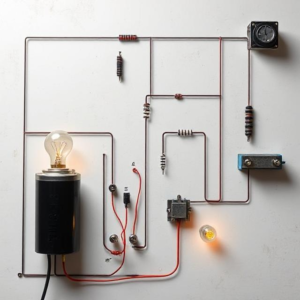In a DC (Direct Current) circuit, the electric charge (current) flows in one direction. The power source in a DC circuit (usually a battery) provides a constant voltage, which causes the current to flow through the circuit components like resistors, light bulbs, motors, etc.

Basic principles and laws that uses DC circuits: Ohm’s Law and Kirchhoff’s Laws.
Ohm’s Law:
Ohm’s Law is one of the most fundamental principles in electrical engineering and describes the relationship between Voltage (V), Current (I), and Resistance (R) in a DC circuit.
Ohm’s Law Formula:
V=I×R
- V (Voltage): The electrical potential difference, measured in volts(V). It is the “push” that makes the current flow.
- I (Current): The flow of electric charge, measured in amperes(A). It’s how much electricity is flowing through the circuit.
- R (Resistance): The opposition to the flow of current, measured in ohms(Ω). It’s like a “blockage” or “friction” for the electric charge.
Understanding Ohm’s Law:
- If you increase the voltage (V), more current (I) will flow (assuming resistance is constant).
- If you increase the resistance (R), less current (I) will flow (assuming voltage is constant).
Kirchhoff’s Laws:
Kirchhoff’s Laws are used to analyze more complex DC circuits with multiple components. These two laws—Kirchhoff’s Current Law (KCL) and Kirchhoff’s Voltage Law (KVL)—help us understand how current and voltage behave in a circuit.
a. Kirchhoff’s Current Law (KCL)
KCL states that the total current entering a junction (node) must equal the total current leaving the junction.
- A junction is where two or more components (like wires) meet in a circuit.
- This is because current (charge) is conserved.
Kirchhoff’s Voltage Law (KVL)
KVL states that the total voltage around any closed loop or mesh in a circuit is always equal to zero. This law is based on the principle of energy conservation. As you go around a loop, the sum of the voltage rises (from power sources like batteries) must equal the sum of the voltage drops (across resistors, light bulbs, etc.).
- Voltage rise happens when the current flows through a battery or power source (positive to negative).
- Voltage drop happens when the current flows through resistors, light bulbs, or any other device that consumes electrical energy.
Tags: amperes (A), battery, Circuit Components, closed loop, constant voltage, current (I), current conservation, current flow, DC circuit, decrease current, Direct Current, electric charge, electric charge flow, electrical energy consumption., electrical potential difference, Electricity, energy conservation, increase current, increase resistance, increase voltage, junction, Kirchhoff's Laws, Kirchhoff’s Current Law (KCL), Kirchhoff’s Voltage Law (KVL), light bulbs, mesh, motors, node, Ohm’s Law, ohms (Ω), one direction, opposition to current, power source, resistance (R), Resistors, total current entering, total current leaving, total voltage zero, voltage (V), voltage drop, voltage rise, volts (V)


